PSYCH 255 Final
1/349
There's no tags or description
Looks like no tags are added yet.
Name | Mastery | Learn | Test | Matching | Spaced |
|---|
No study sessions yet.
350 Terms
what are different names of the study of behaviour from a biology perspective?
-biopsychology
-neuropsychology
-psychobiology
-neurobiology
-cognitive neuroscience
-physiological psychology
-behavioural neuroscience
what is the brain?
-tissue within the skull
-the brain is a physical organ
-produces behaviour and is affected by behaviour (the brain changes in response to our behaviours and it is constantly learning and adapting based on what a person is doing)
what is behaviour
an observable phenomenon produces by the nervous system that has both a cause and a function
-everything that we do and the processes that are working behind the scenes in allowing us to do what we do (why the definition is so broad, bc/ its everything)
what is nature vs. nurture?
-nature: behaviour is a product of our biology
-nurture: behaviour is produced by are experiences in life
t or f: brain and behaviour are affected by both nature and nurture?
true
-they both interact and affect each other
the ____________ produces behaviour and _______ affects the brain
brain
behaviour
ex. of how both the brain and behaviour interact and affect each other
-person is a great violin player
-has good biological predispositions to do so
-even if they have that (the nature) and pick up a violin for the first time they will be bad
-therefore they also need the nurture to become good (lessons)
perspectives on the brain and behaviour
is the source of behaviour from the mind or the brain?
-is behaviour from a non-material entity or a physical structure?
how did mentalism view the brain and bahaviour and who was apart of it?
-aristotle: believed brain and behaviour lived in our heart but was non-physical
-an explanation of behaviour as a function of the nonmaterial mind that is independent of the physical body but responsible for behaviour
how did dualism view the brain and bahaviour and who was apart of it?
-Rene Descartes
-a nonmaterial mind (that is found inside the brian) and the material body contribute to behaviour (the mind and brain interact to produce behaviour)
-created a mind-body problem: how can something thats non-material (mind) influence something physical (brain and body)?
-the non material mind directs rational behaviour
-body and brain direct all other behaviour via mechanical and physical processes (ex. sensation, movement, and digestion)
-the mind is located in the pineal gland (but isn't the pineal gland its just where the mind lives) of the brain, which sits beside ventricles filled with fluid
-believed that the mind would continue on after the body died
-mind regulates behaviour by directing the flow of ventricular fluid to appropriate muscles
why was the pineal gland chosen for the home of the mind in dualism?
-picked bc/ it was so small (the body only lives once but the mind lives forever so it only needs a small space) and bc/ of its location
what were some problems with Descartes' Theory in Dualism
-pineal gland is involved in biological rhythms, but not intelligence or behavioural control
-fluid is not pumped from the ventricles to control movement
how did materialism view the brain and bahaviour
-behaviour can be explained as a function of the nervous system without explanatory recourse to the mind (without a non-material mind and is just a brain but the mind is produced by the brain)
-our brain causes our behaviour and the mind is a product of the brain
what perspective do we follow in this class?
materialism
what proof do we have the materialism is how the brain and behaviour interact?
-case studies of individuals with brain damage clearly indicate that the brain controls behaviour and produces 'mind'
who was Phineas Gage and what happened to him?
-an accidental explosion that put iron straight through his head
-didn't put sand over dynamite and sent a pole straight through his head
-was a very level headed man before hand
-he physically healed but was now impatient, disrespectful, stubborn, and unpredictable
-when you physically change the brain, then the mind changes too
what surprised Alfred Wallace and Charles Darwin about speicies?
-were both struck by the many similarities among species
-said that all living thing are related to each other
what did Alfred Wallace and Charles Darwin question about speicies?
-questioned how species could be so different, yet similar at the same time
-led Darwin to propose his theory of Natural Selection
what is Natural Selection?
-involves the gradual change in the frequency that a gene is expressed within a population (occurs over many generations)
-there are some characteristics that are passes down through generations
-organisms that have advantageous traits for the environment that they live in will be able to survive and procreate, thus passing on their advantageous traits to the next generation
-the more an organism procreates, the greater representation of their genetic material and associated traits are the in next generation (only if the traits are adaptive to the environment that future generations will live in- if maldaptive= survival of the fittest extension)
explain how moths were an example of natural selection
-old trees had lichen on them that made the trees light coloured
-light moths were a better fit for survival and were more likely to pass on their genetic material then dark moths
-then the lichen started to die so the trees were dark
-this made the dark moths have a better fit for survival and then they were more likely to pass on their genetic material
-having both coloured moths= variation within species which is good incase the trees go back to having lichen on them (this is how species do not extinct when having to undergo environmental changes)
how are traits selected naturally?
genetic variation between individuals-adaptive trait (good fit for environmental survival)- increases chances of survival- trait passes on to offspring
what are the implication of natural selection?
1. brains/neurons are related (enables animal modules for studying structures and functions and extend the findings to humans (better figure out how we work)
2. behaviours are related (enables animal modules for studying behaviours such as using rats to learn more about addictions in humans)
3. complexity in brain and behaviour evolved gradually, in response to environmental demands and experience
why study brain and behaviour?
-Many behavioural disorders can be explained and possibly cured by understanding the brain (understanding genes and hormones can help know if there is treatment to the disorder)
-the brain is the most complex living organ on earth (how the brain produces behaviour is a major unanswered scientific question)
dorsal
-meaning above
-sometimes refered to as superior
-with dorsal fin it is on the top
ventral
-means below or belly
-sometimes referred to as inferior
anterior
-meaning front (towards the front)
-sometimes referred to as frontal or rostral (towards the beak)
posterior
means toward the back
-sometimes referred to as caudal (towards the tail)
-towards the rear
medial
-means middle
-towards the midline
-can be referred to as mesial
lateral
means side
-towards the side
dorsal side of spinal cord vs. brain
when a human is on all 4s the dorsal side is the back bc/ its still the top and posterior is at the feet
horizontal plane
-aka axial plane or transverse plane
-cut between top and bottom of the body
sagittal plane
-cut between left and right of the body
coronal plane
-cut between front and back of the body
contralateral vs. ipsilateral
-contralateral: "opposite" pathway that is on one side crossing over to the other side (when looking at right visual field the left motor cortex on the left side of the brain controls the right hand when the hand goes to reach out to feel what is on the right visual field)
-ipsilateral: pathway stays on the same side (ex. smell: right olfactory bulb stays on the same side when sending messages to the right olfactory cortex)
afferent vs. efferent
afferent: incoming, sends signals to the brain (sensory)
efferent: outgoing, reaction, leaves brain and sends signals to react (motor)
Sensory
Afferent
Motor
Efferent
what are the brains primary functions?
1. create a sensory reality
2. integrate and store information
3. produce behavioral response
how does the brain sense reality?
-brain interprets sensory information to provide us with information about the world
-varies across species (bc/ its subjective) and is based on species' survival needs (ex. bats compared to humans, bater main senses are used for eco-location)
-varies across individuals (ex. some people are colour blind so the brain cant provide them with all the colours bc/ it cant interpret the sensory information)
how does the brain integrate and store information?
-sensory information has to come in and that interpretation had to happen
-the sensory information then get compared with past knowledge so we can integrate it and know what has happened (ex. "ding dong" we hear it and through past knowledge we realize someone is at the door)
how does the brain produce behavioural response?
-we need to do something with the information we have received (ex. get up and go answer the door)
what is the nervous system made up of?
brain, spinal cord, nerves (cranial and spinal)
what does the nervous system do?
receives information (goes to the brain)
-interprets information (in brain or spinal cord)
-generates responses to the information (leaves brain)
the nervous system is divided into 2 main parts
Central Nervous System (CNS)
Peripheral Nervous System (PNS)
Organization of the nervous system
-split into CNS and PNS
-CNS: brain and spinal cord
-PNS: splits into Somatic NS and Autonomic NS
-Somatic NS has both afferent and efferent nerves
-Autonomic NS has both afferent and efferent nerves: efferent nerves splits into sympathetic NS and parasympathetic NS
also look at diagram on slide 19 for more detail
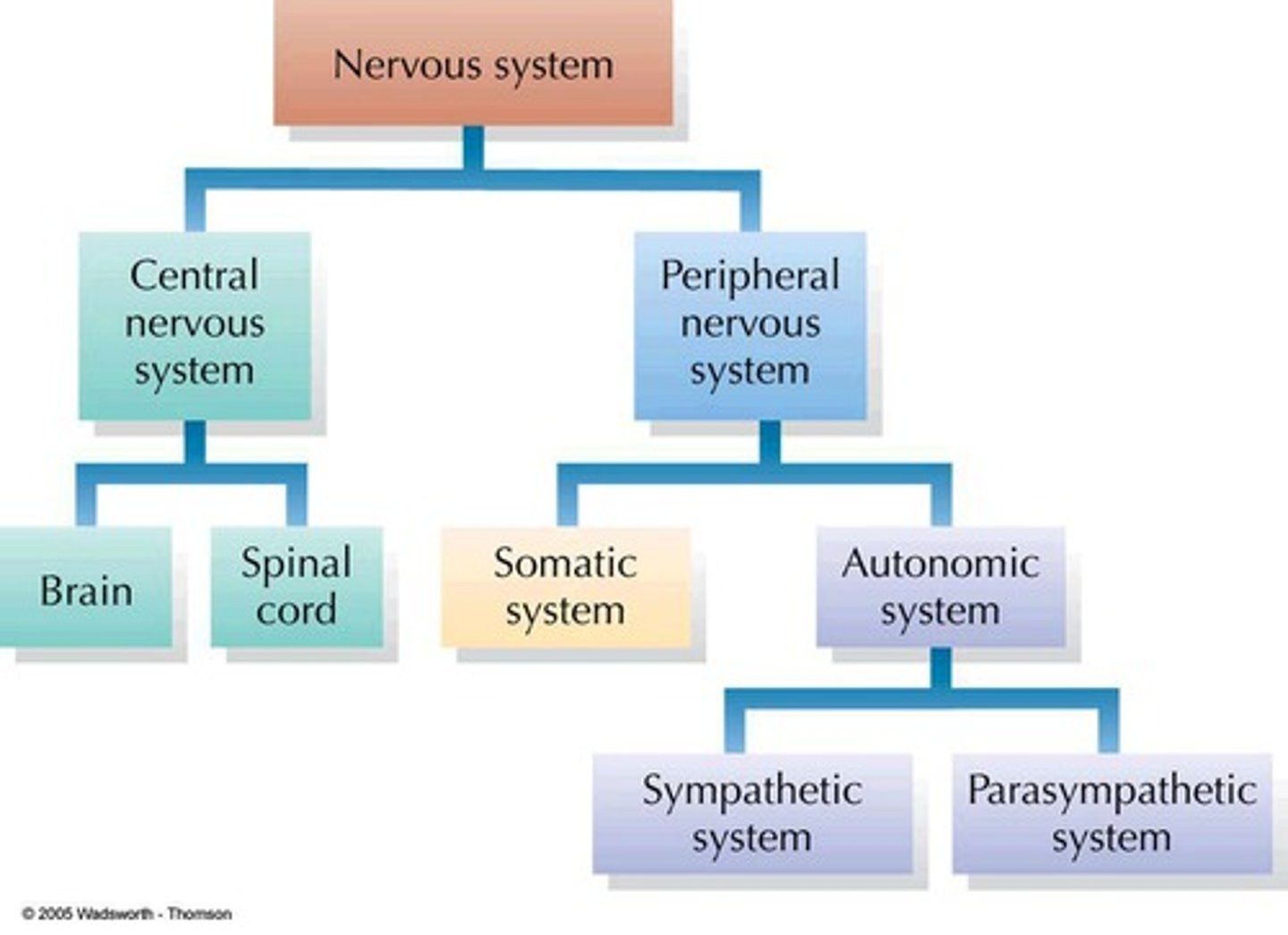
what does the CNS do?
-receives, processes, interprets, stores, and responds (generates response) to sensory information
what is the CNS made of
brain and spinal cord
what is the spinal cord?
-an extension of the brain
-a collection of neurons and supportive tissue running from the base of the brain down the center of the back
-protected by the spinal column (collection of small vertebrae put into 5 major groupings)
The spinal cords role in the CNS
-bridge between brain and spinal nerves
-role in voluntary movement and automatic functions (carries sensory into to brain and carries motor commands from the brain)
-also controls spinal reflex: automatic response that is independent of the brian (spinal reflex happens without the info reaching the brain) ex: patellar tendon reflex- spinal cord gets info so fast that you kick your leg out before that info has reached the brain, then once it does reach the brain you realize that you have been hit and are in pain)
injury to what body part leads to paralysis?
spinal cord
what is quadriplegia?
-damage to the cervical area of the spinal cord
-loose function neck down
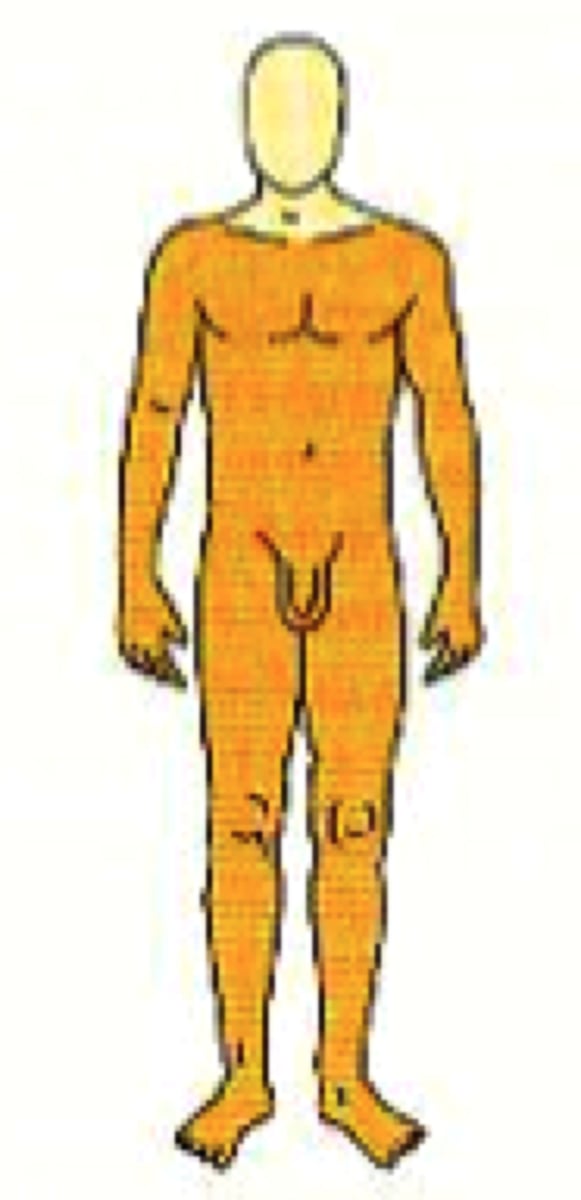
what is paraplegia?
damage to the thoracic or lumbar area of the spinal cord
-loose function to legs but not arms
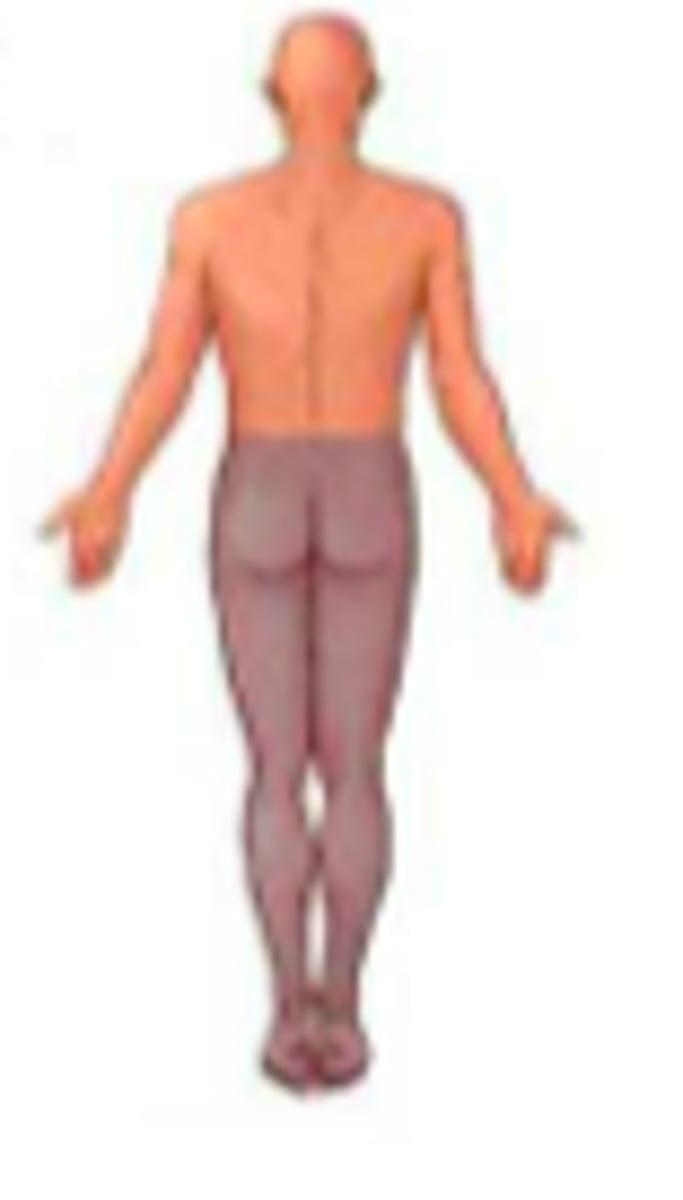
what does the PNS do?
provides information to the CNS, and is provided with response information from the CNS
somatic nervous system
-soma means body bc/ it helps move our body around and receive sensory information and where our body is in time and space (physically move body and receive sensory information from the world around us)
-has sensory nerves (afferent) that get messages from receptors in skin, muscles, joints, and sense organs (5), and send them to the brain and spinal cord
-has motor nerves (efferent) that carry messages from the brain and spinal cord to the muscles that allow our body to move
-the cranial nerves are monitored by the brain
-the spinal nerves are monitored by the spinal cord
cranial nerves
-12 pairs of nerves (12 on left side and 12 on right side)
-supply sense organs and muscles of face and head to the brain
-the nerves have sensory functions, motor function, or both ('mixed nerves')
the 12 cranial nerves and if they are sensory, motor, or both and the 4 cranial nerves that have both somatic and autonomic functions.
1. Olfactory: sensory
2. Optic: sensory
3. Oculomotor: motor and both somatic and autonomic
4. Trochlear: motor
5. Trigeminal: both
6. Abducens: motor
7. Facial: both and both somatic and autonomic
8. Auditory vestibular: sensory
9. Glossopharyngeal: both and somatic and autonomic
10. Vagus: both and somatic and autonomic (special nerve)
11. Spinal accessory: motor
12. Hypoglossal: motor
Some Say Marry Money But My Brother Says Big Brians Matter Most
spinal nerves
-each nerve contains both sensory and motor fibers (mixed nerves)
-a single dermatome (area of skin that rely on specific nerve connection on your spine) is supplied by each nerve
What are spinal nerves groups and how many are there?
8 cervical
12 thoracic
5 lumbar
5 sacral
1 coccygeal
31 total
what is the Law of Bell and Magendie?
-sensory fibers of our spinal nerves are entering the spinal cord on the dorsal side (when on all 4s)
-motor fibers of our spinal nerves are exiting the spinal cord on the ventral side
-when upright sensory fibers are on posterior side and motor fibers are on anterior side
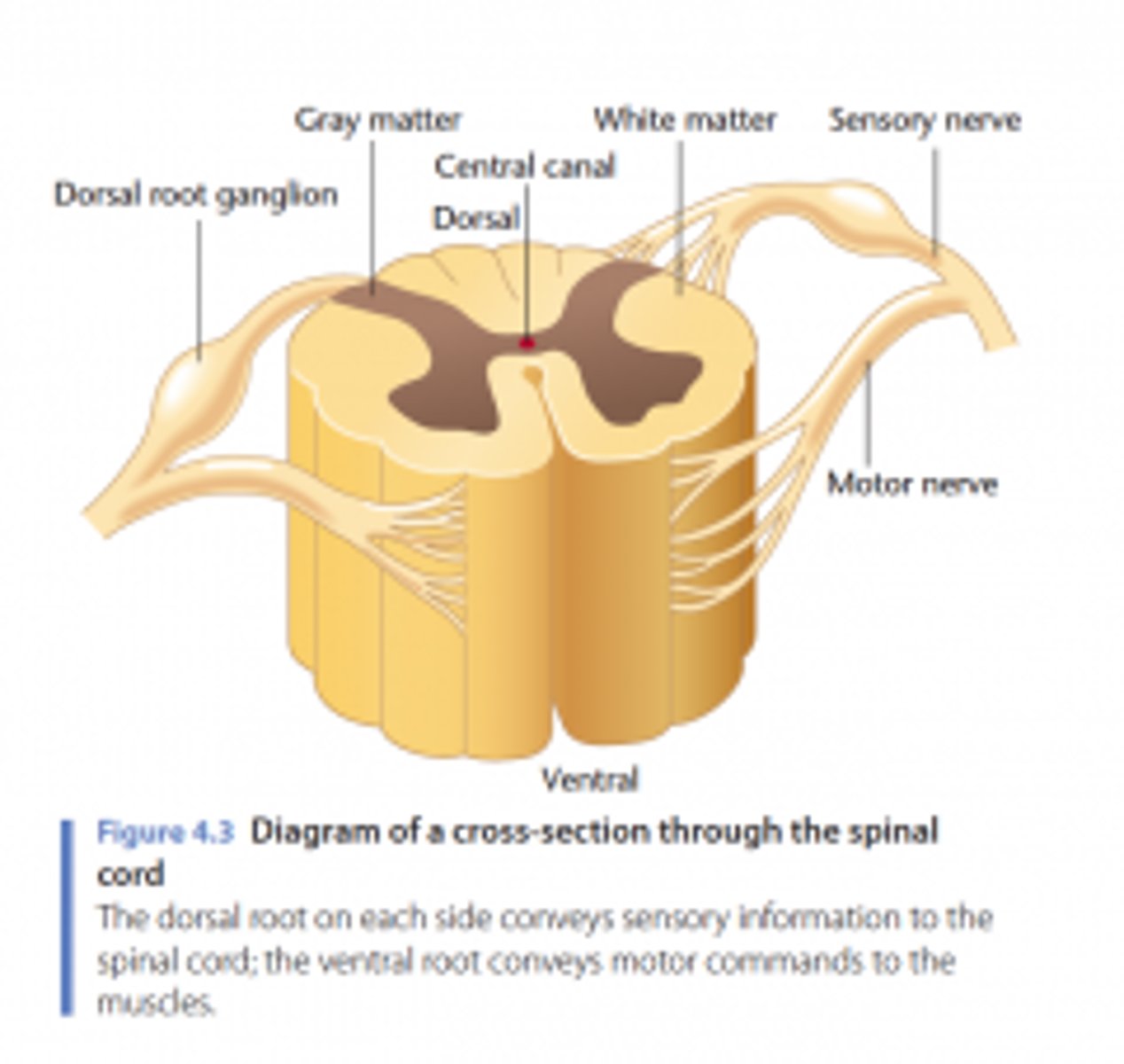
autonomic nervous system
-a lot of the functions happen with our unconscious awareness
-includes enteric NS
-regulates internal states
-afferent nerves (sensory) carry information from internal organs
-efferent nerves (motor) connect to the internal organs and has the sympathetic NS and parasympathetic NS
sympathetic nervous system
-initiates "flight or fight" response
-arouses body during times of stress (body redistributes our resources to deal with whatever the source of stress if by increasing activity of some components but decreasing activity of other components)
-completely made of spinal nerves
parasympathetic nervous system
-allows body to "rest and digest" (brings body back to homeostasis)
-conserves energy and allows non-emergency processes to occur
-comprised of 4 cranial nerves and some spinal nerves coming off the sacral level (crainal nerves: oculomotor nerve (3), facial nerve (7), glossialpharangial nerve (9), and vagus nerve(10)
what is the meninges and what are the different parts?
meninges: connective tissue found outside of the brain between the skull
-dura mater: tough outer most layer (very thick and opaque)
-arachnoid layer: under dura mater (web like apperance)
-pia mater: soft layer closest to the brain
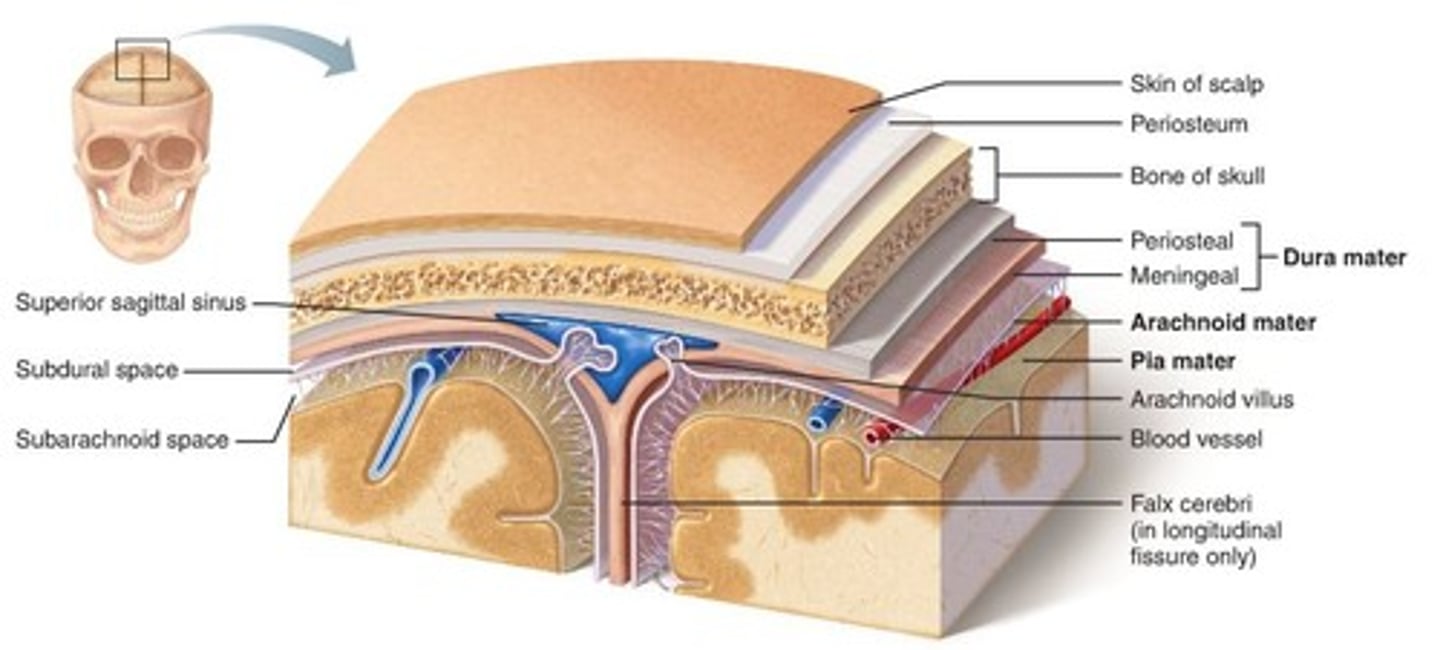
what is the subarachnoid space?
between arachnoid later and pia mater
-space filled with cerebral spinal fluid (CSF)
-CSF cushions the brain for protection and makes it so it doesn't bang around in the skull
cerebriospinal fluid (CSF) what does it do?
-made from our blood
-fills the ventricles
-circulates around the brain through the ventricles and spinal cord in the subarachnoid space
-cushions the brain
-transports substances into and out of the brain
gyri, sulci, fissures
-characterized by bumps and valleys
-gyri: bumps/ protruding parts
-sucli: shallow valley/ gaps (found between gyri)
-fissures: deeper valleys (have fewer of them)
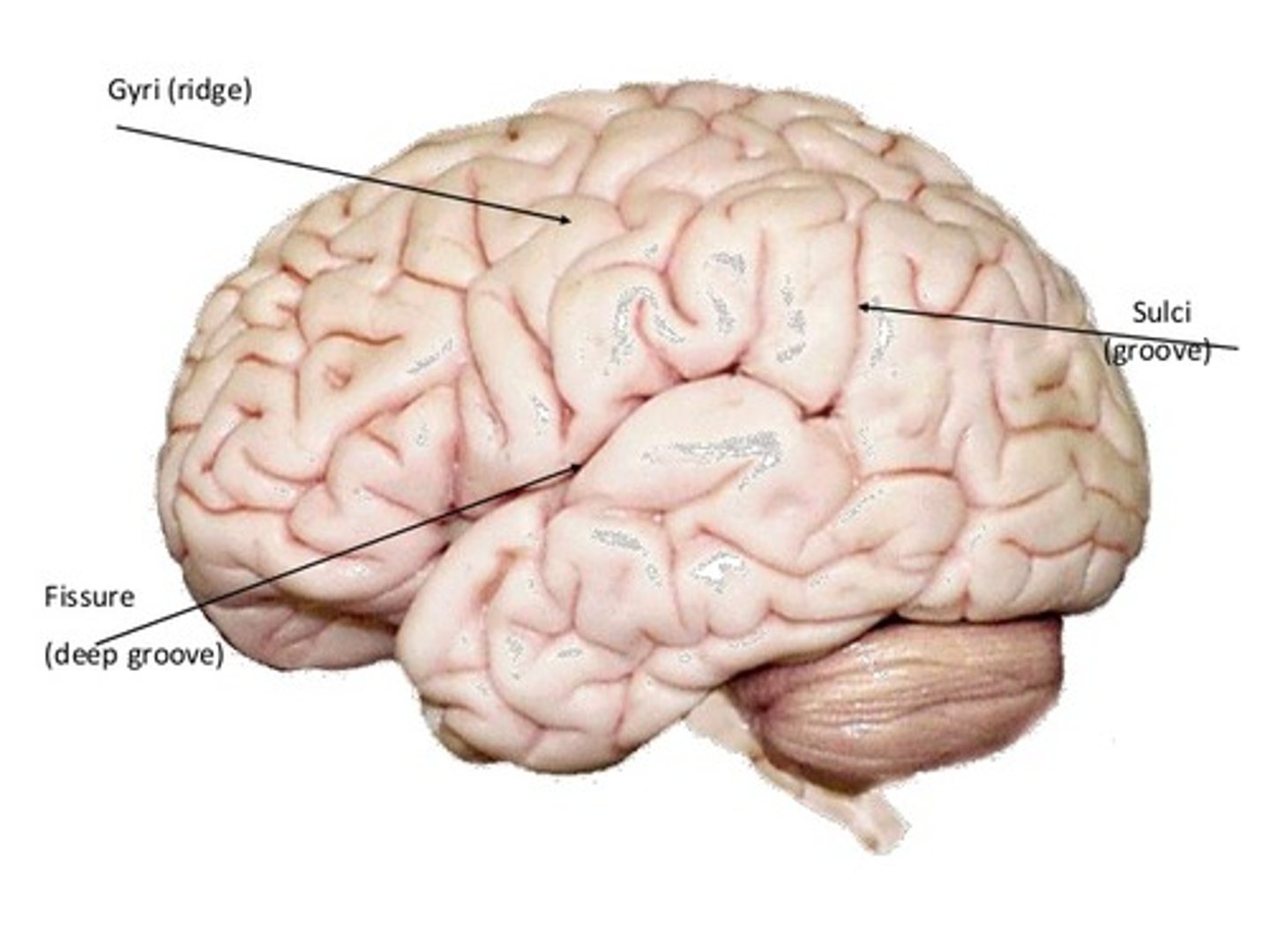
what are the major fissures in the brain?
-central fissure: central to the front vs. back of the brain (anterior vs. posterior) separates frontal lobe and parietal lobe
-longitudinal fissure: longest, separates left and right hemispheres
-lateral (Sylvian) fissue: separate temporal lobe from frontal lobe (at the anterior) and parietal lobe (at the posterior side)
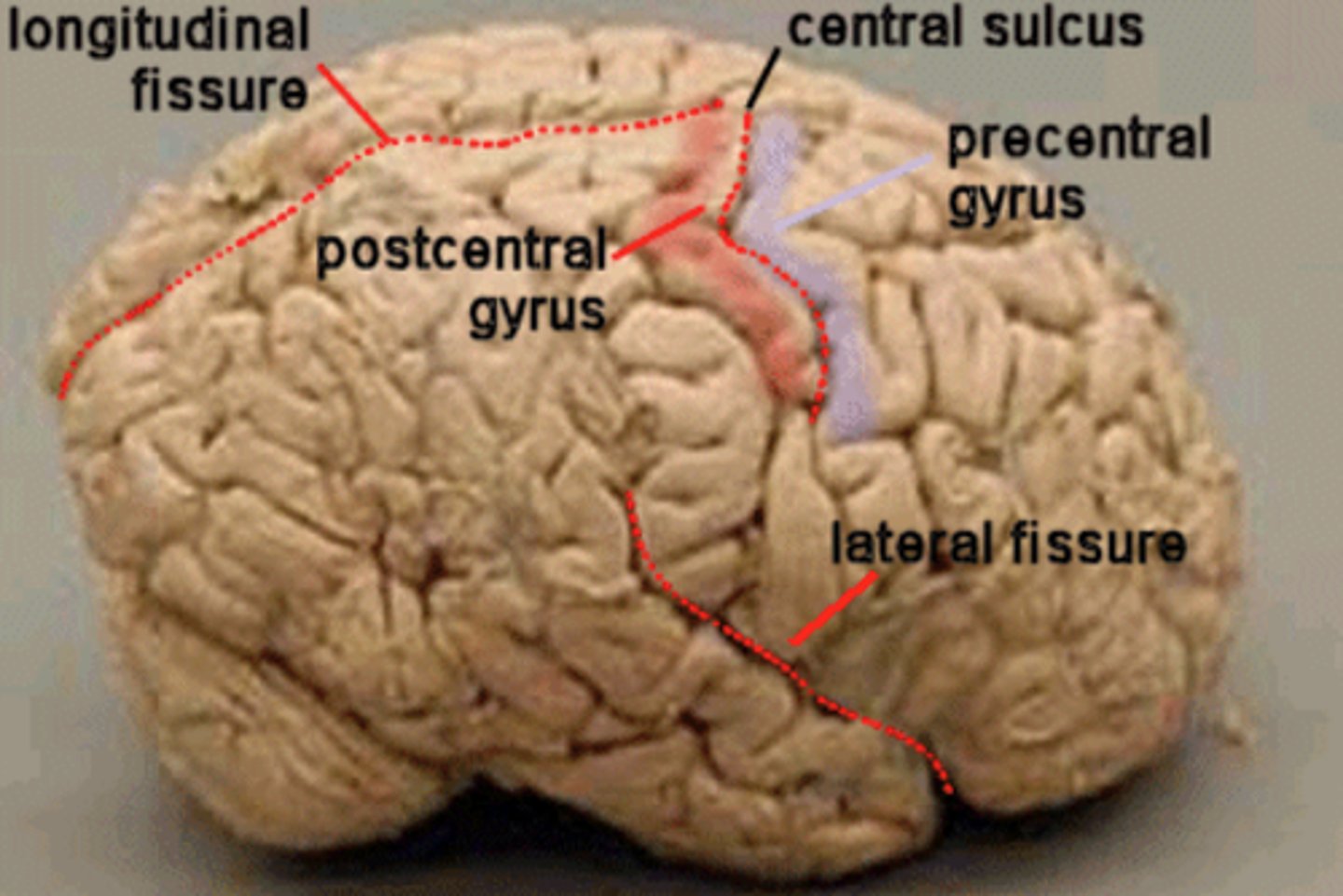
what are the four main lobes in the brain
-occipital lobe (posterior)
-parietal lobe
-temporal lobe (hint: found around your temples)
-frontal lobe (very large and at the front)
-insula lobe (fifth lobe and can't see unless you pry open the lateral fissure)
what are the major surface structures of the brain?
-4 lobes
-cerebellum ("little brain" at the back of the brain)
-brainstem
-cranial nerves
what are the brains major internal features
-white matter
-gray matter
-ventricles
white matter
-type of tissue
areas of nervous system rich with fat-sheathed neural axons (myelin) (has myelinated axons (fatty covering))
-the out-put pathways
gray matter
-type of tissue
-areas of the nervous system predominately composed of cell bodies and blood vessels
-dendrites and cell bodies are found (non-myelinated and is part of the same cell that has the myelinated axon in the white matter)
ventricles
-holes in the brain
-a cavity in the brain that produces and contains cerebrospinal fluid
-where CSF is made
what is the ventricular system?
-found within the brain and are not any structure (they are holes)
-lateral ventricles: one in left and one in right hemisphere
-third ventricle: found at the midline, has a little dot in the middle that connects the left and right thalamus
-fourth ventricle: found at the midline, tucked between cerebellum and other brain structures (where CSF leaves)
-all are connected to each other and are all connected to the central canal
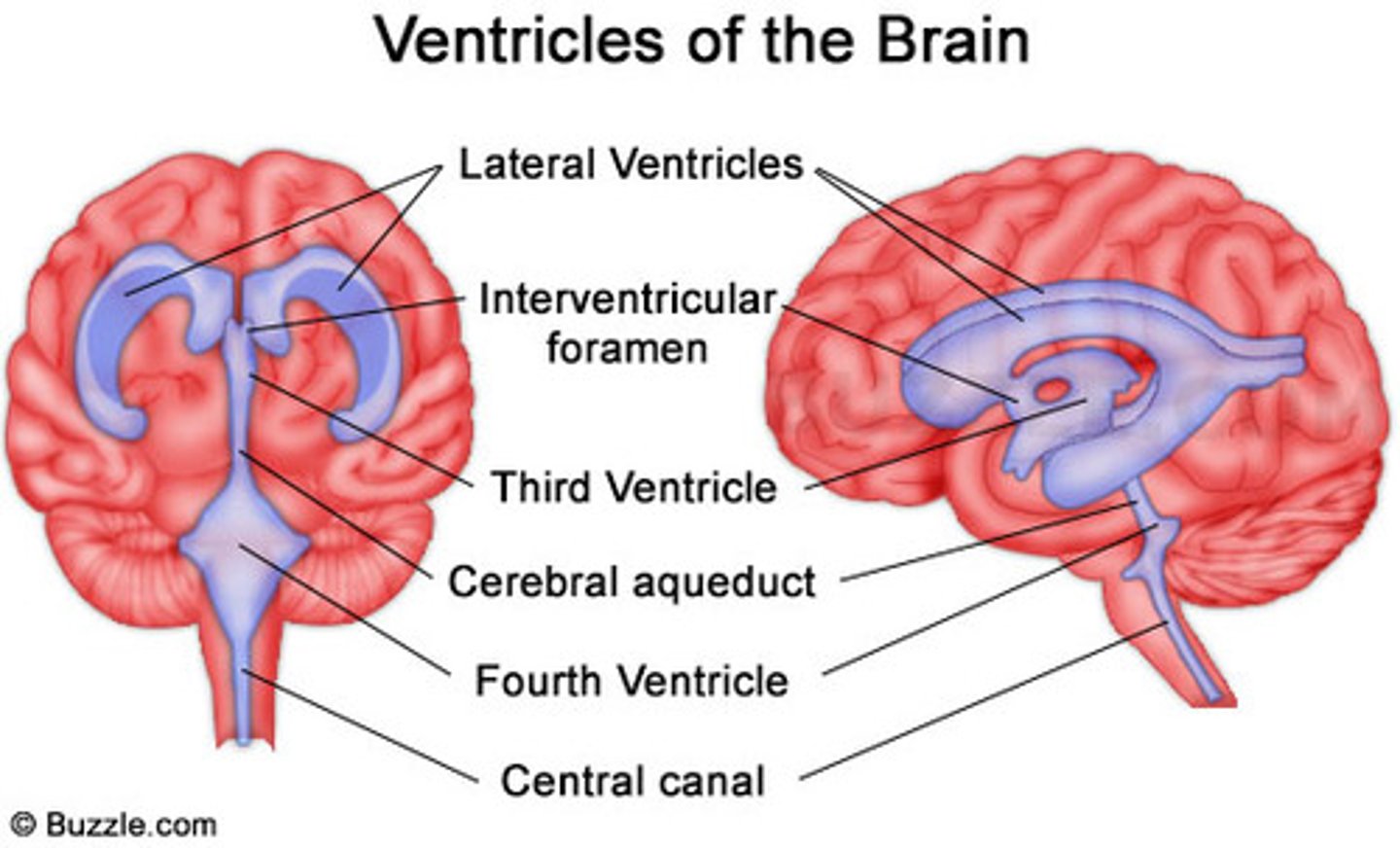
functions of ventricles
-role in brains metabolism
-cushions the brain
what is the corpus callosum
-band of fibers connecting the two cerebral hemispheres
-above corpus callosum the 2 hemispheres do not connect
-longest commissure in the brain (connects parts of the brain)
What is a commissurotomy?
-"split brain"
-severing the corpus callosum
used to stop certain types of epilepsy the corpus callosum will be severed along with other commissures and seizures will stop (damages certain brain functions as the hemispheres can not longer communicate)
what does the brainstem do?
-controls movement and creates basic sensory reality
-made of three parts: hindbrain, midbrain, diencephalon
hindbrain
-lowest component of the brainstem
-contains cerebellum, medulla oblongata, pons, and reticular formation
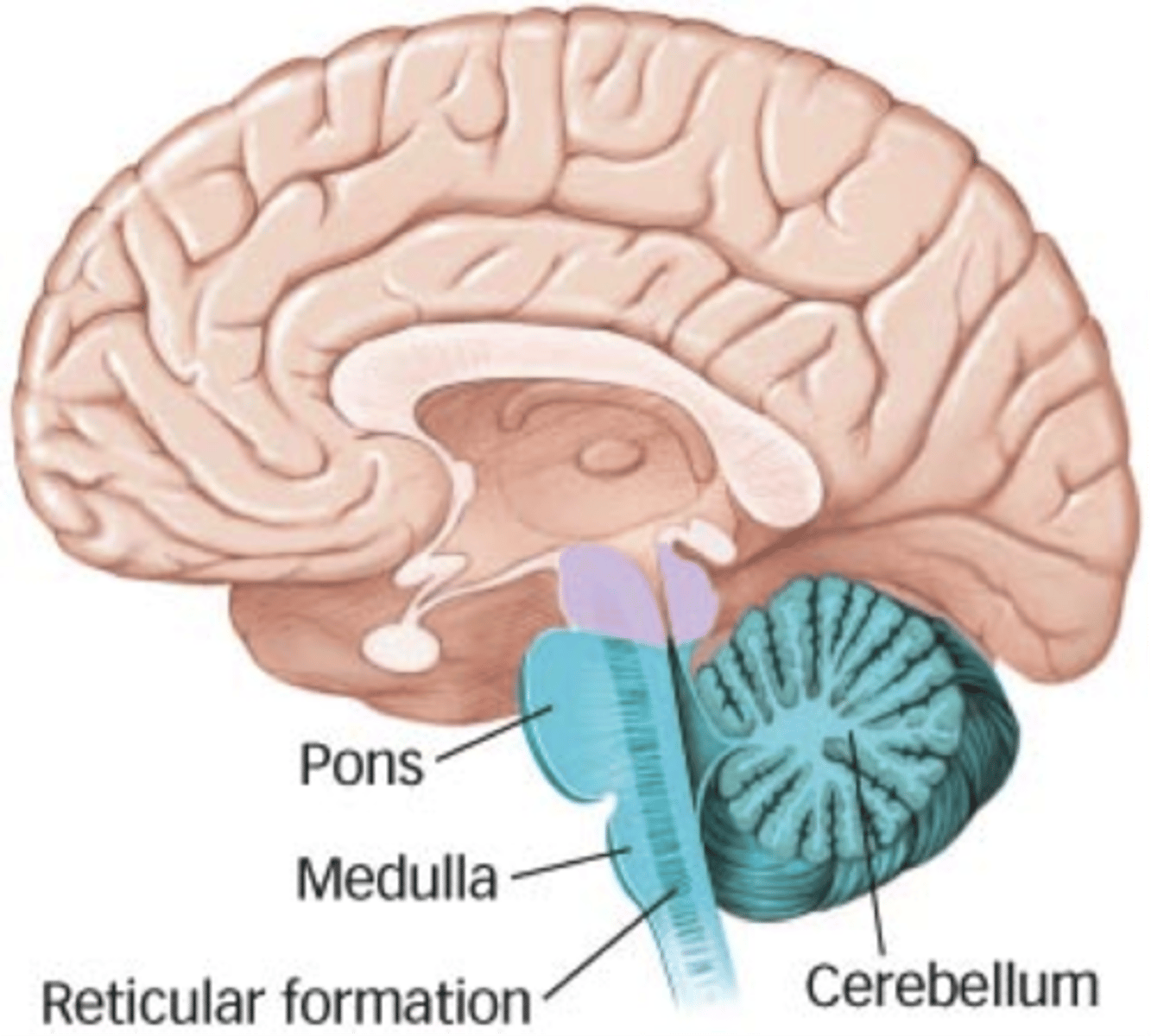
cerebellum
-"little brain"
-allows us to move quickly, plan movements
-involved when we learn and recall basic procedural memories
-motor coordination/ balance (bigger in species with more coordination)
-cognitive functions
medulla oblongata
-comprised of many densely packed nuclei
-vital functions: life support functions (respiration, breathing, coughing, swallowing, vomiting)
-connects directly to spinal cord
-motor pathway functions cross here when going to limbs
-vagus nerve comes off here
pons
-connects to the cerebellum
-cranial facial nerves come off there
-active during REM sleep
-the "bridge" between the spinal cord and medulla, higher brain regions, and cerebellum 3 ways: sharing information, allows for motor commands to be sent out, sensory pathway
reticular formation
-forebrain arousal (how awake or sleepy we feel)
midbrain
-has the tectum (floor) and tegmentum (roof)
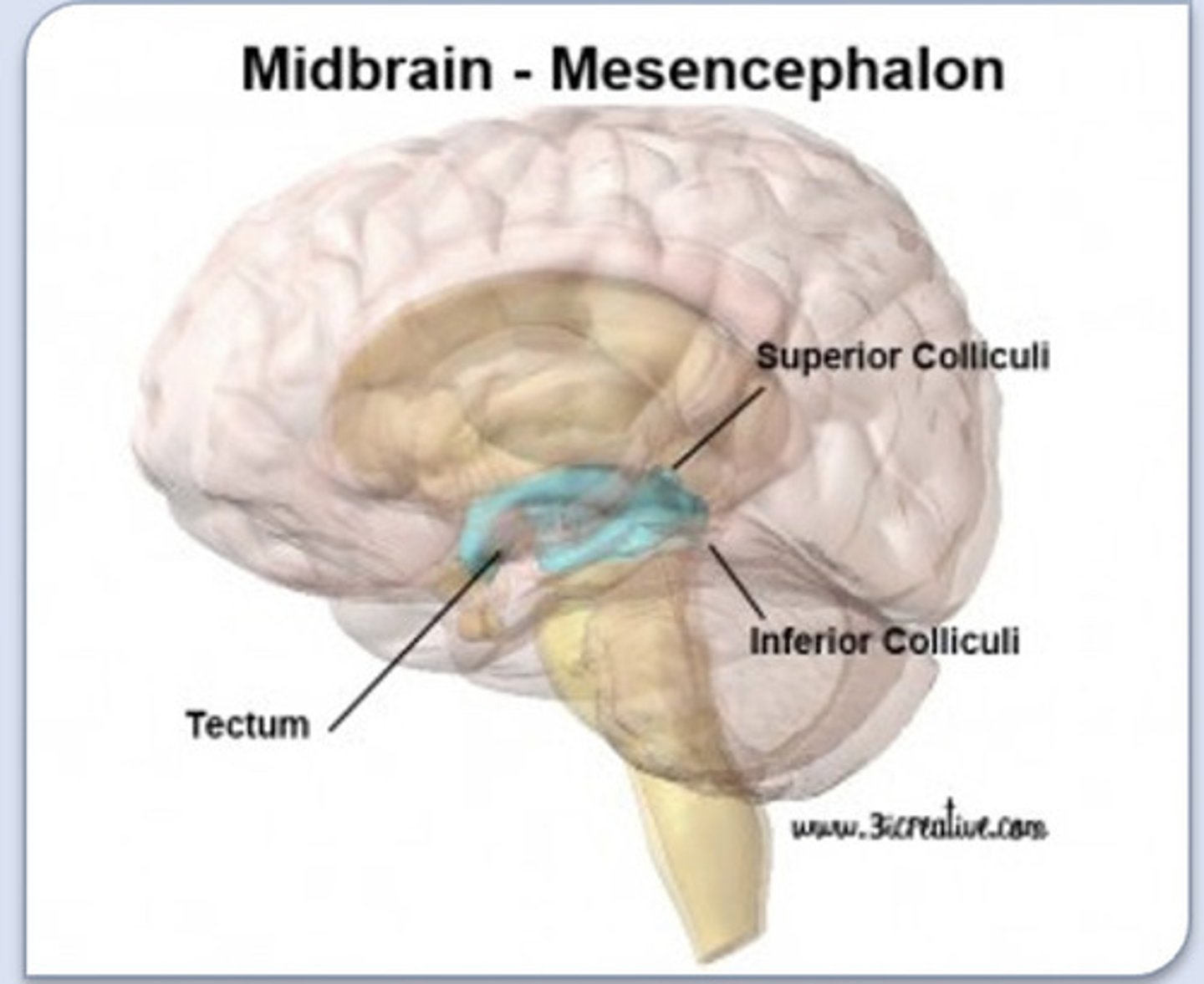
tectum
-contains superior colliculi (above hill) (visual), interior colliculi (below hill) (auditory)
-used for reflexive orienting: allows us to turn our head in response to visual stimuli (superior) or auditory (inferior) (we turn our head before we consciously know why we turned our head)
tegmentum
-nuclei involved in sensation and movement
-perception of pain
diencephalon
-contains hypothalamus and thalamus
hypothalamus
-under thalamus
-controls autonomic nervous system by sending signals
-temperature regulation, eating (full or hungry), drinking, sexual behaviour
-controls hormones by working with the pituitary gland (increases or decreases amount of hormone from the help of pituitary gland)
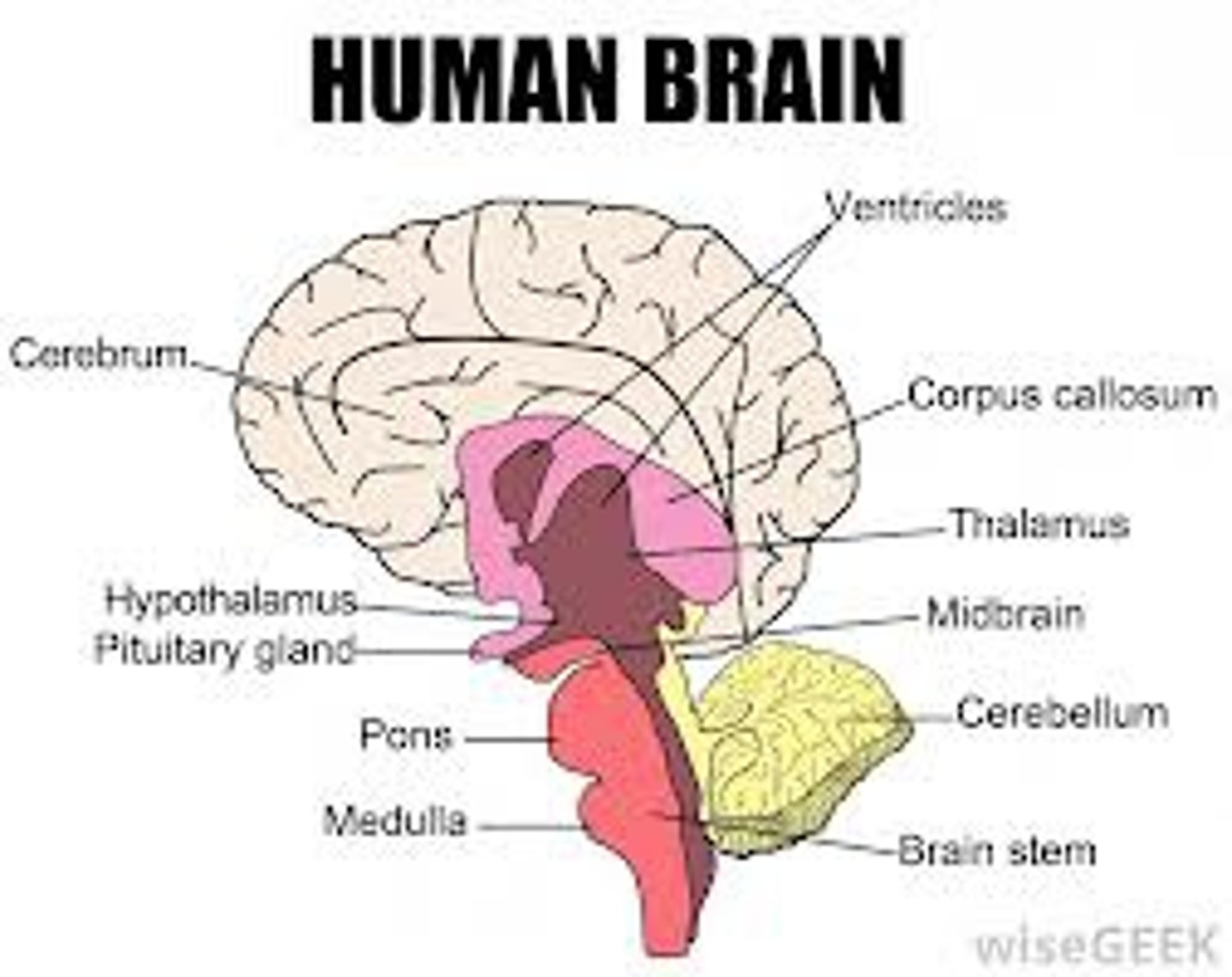
thalamus
-one in left and right hemisphere
-sensory and motor gateway
-directs sensory info to the correct part of the cortex where we than become consciously aware of it
-re-directs the flow of motor info to the correct cortex (only if going up! not down)
-comprised of multiple nuclei
forebrain
-largest part of the brain in mammals
-has the highest amount of function
what are the three parts of the forebrain
neocortex, limbic system, basal ganglia
basal ganglia
-contains the caudate nucleus (outer shell), putamen, and globus pallidus (internal and external: "pale globe")
-comprised of multiple nuclei
-one in left and one in right hemisphere
-important for controlling voluntary movements (not producing movements )
-help normal movement occur by sending messages to the motor cortex to refine the movements that are produced by the motor cortex (force my permitting release of movement OR less force by inhibiting movement)
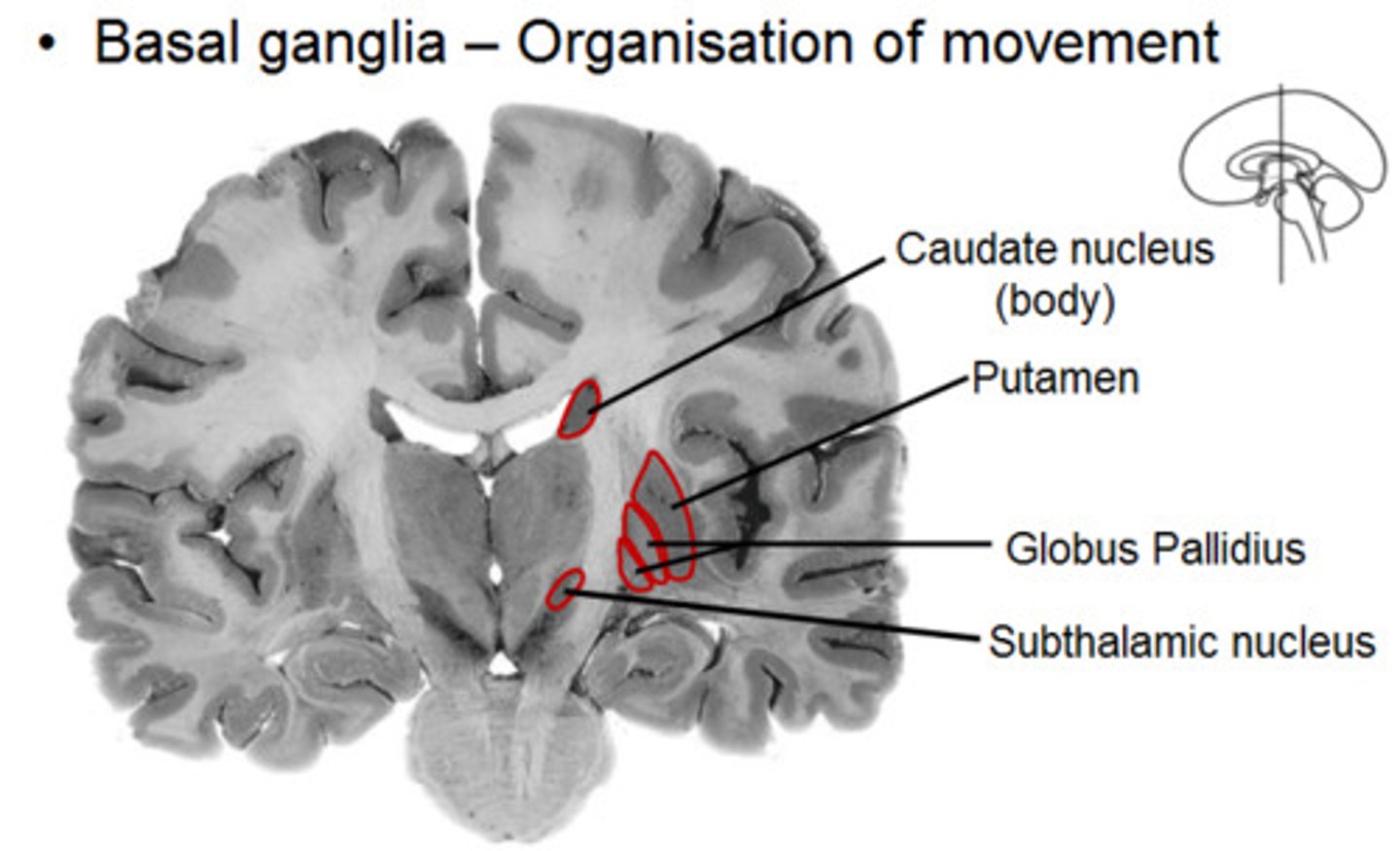
diseases associated with basal ganglia?
-Parkinson's disease: damage with cell death in substantia nigra and therefore can't give enough dopamine to basal ganglia bc/ of cell death=less movement
-Huntington's disease: hyperconnectic disorder= too much movement therefore the caudate nucleus and putamen experience cell death= uncontrolled release of movement
-tourettes: vocal ticks and motor ticks (uncontrolled) bc/ a person has a smaller basal gnaglia
limbic system
-means boarder or hem
-between the neocortex and brainstem
-principle structures include: Amygdala, Hippocampus, Cingulate cortex
-processes in emotion processing, memory and spatial navigation, and motivation and cognition
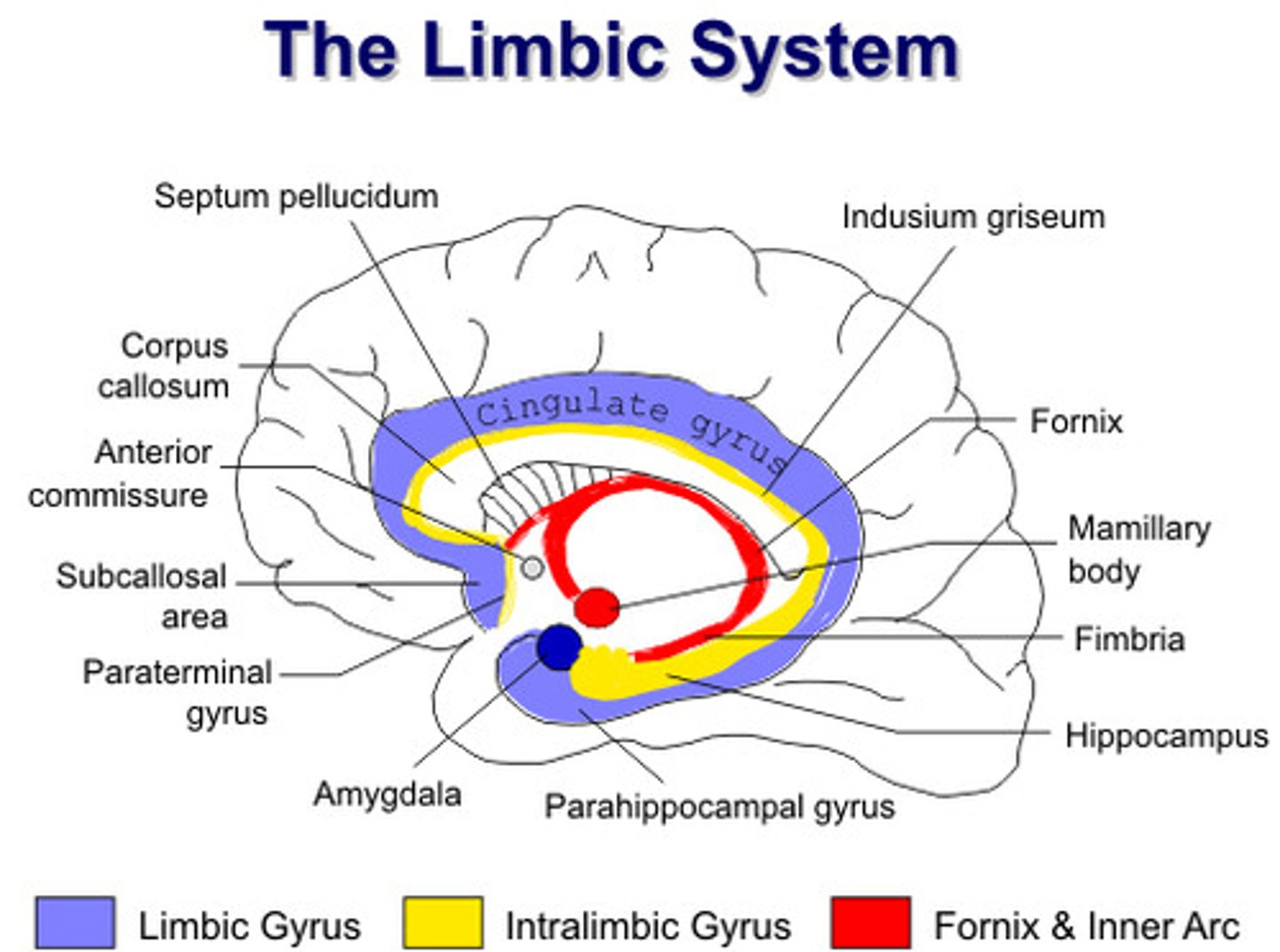
amygdala
-means almond
-emotion processing: involved in initial production and perception of emotion and assesses emotional significance of the emotion (threat detector)
-people with depression have a highly more active amygdala
-associated mainly with fear and anger
hippocampus
-only are in the brain where new neurons are formed (neurogenesis)
-involved in memory (memory formation of non spatial memories, formation of new episodic memories (memories about ones self), creation of new semantic memories (memories of functional info) *note: memories are not stored here, and spatial navigation
cingulate cortex
-cognitive and emotional processing
-has a lot of shared functions with the cortical regions around it
-active when experiencing emotions (especially pain and regret)
-helps understand emotions of others (empathize), and predict another persons intentions
-helps control/ regulate emotions
-helps us pay attention to info being presented to us, planning and decision making
evil dog vs. nice dog: which would you pet and why?
-nice dog: used your amygdala to determine the emotions the dogs are presenting and the threat associated with the evil dog
cortex
-outermost layer of the forebrain but very thin
-contains the four lobes
what are the four lobes in the brain
frontal, parietal, occipital, temporal
occipital lobe functions
-has the fewest functions
-visual functions
Visual Association Area:
-lets us see forms/lines of objects (ex. a table we an see its shape and lines that make it into a square)
-processes visual info the the next level (just past our conscious awareness)
-lets us perceive colour
-allows us to perceive object movement (damage to area=objects look frozen)
what are the steps of how we consciously become aware of visual info
-vision comes through eyes, progresses back through optic nerve, crossover the optic track, and to the primary visual cortex where we become aware of visual info consciously)